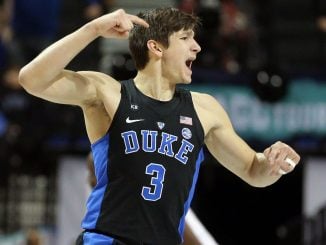Controversy between amateurism and professionalism has surrounded the world of college sports since the very first intercollegiate rowing contest between Harvard and Yale in 1852.
Murray Sperber wrote, “Even before the starting gun went off or an oar hit the water, two elements were at play: the event was totally commercial and the participants were cheating.”
The time has come to decide whether Division I athletics returns to the idealized notion of purity in college sports or abandons all pretense, accepts the inevitable and adopts a form of professional sports in football and basketball.
The argument goes that big-time D-1 college programs need the revenue from these two sports or else every other sport may cease to exist.
Dr. William Friday and Dr. Theodore Hesburgh figured it out in 1991 when they co-chaired the first Knight Foundation Commission on Intercollegiate Athletics. They called for a new model, stating:
“At their worst, big-time college athletics appear to have lost their bearings. With increasing frequency, they threaten to overwhelm the universities in whose name they were established and to undermine the integrity of one of our fundamental national institutions: higher education.”
It’s difficult to make the argument with a straight face that Division I athletics programs today are truly focused on academics, campus engagement and the overall well-being of student-athletes when the questions are not about adjusting game and practice schedules to allow more time in the classroom, the lab or student clubs.
The most pressing questions are whether student-athletes should be allowed to be compensated for “name, likeness and image” and whether they should be treated as employees of the colleges and universities for whom they play.
Many people involved in college sports today will admit, in private, that the system is truly broken. The two sports that pay for all the others, football and basketball, are no longer 100% grounded in promoting amateurism and campus life. Frankly, none of this is particularly new, as college sports has been sitting in the middle of the intersection, hoping that whatever collisions may occur don’t destroy the entire system for decades.
Isn’t it time to stop ignoring the underlying problems? How might we bring this charade to an end and move down the road of authenticity? Perhaps a three-prong approach provides a viable solution:
Follow the lead of Division III schools and stop providing athletic scholarships, as these grants-in-aid appear to no longer carry the value they once did, especially in this age of one-and-done in basketball.
In the spirit of returning to a student-athlete model, allow freshmen to be members of teams but don’t permit them to travel or compete.
In an attempt to bring coaches’ salaries back to an acceptable level, cap them.
These changes might impact revenue in a major way; but, so what? Each year, only 15 to 25 Division I schools actually make money or break even on athletics.
If generating revenue remains an objective while also desiring to move in a non-hypocritical, more genuine direction, why not consider the most obvious solution? Division I schools could create and own professional sports teams, at least in football and basketball, that carry the school brand yet are comprised of athletes who are NOT students.
This would enable the team members to be committed to strength building, conditioning, practicing and playing on a full-time basis, while representing the school as paid, professional athletes. Consider the possibility of the “Durham Blue Devils, Sponsored by Duke University” or the “Chapel Hill Tar Heels, sponsored by UNC.”
It may sound like European soccer, but if it provides the revenue to support dozens of other programs, so be it. At least it’s honest.
Do we return to an old-school model with true amateurism as its goal, or do we embrace the professional, revenue-generating aspect of Division I athletics and admit the truth of what has been going on in college sports for decades?
In 2012, Dr. Friday was still talking about his concerns related to college sports: “Yes, money flows in from the television networks. But when you expand stadiums and pay big salaries, you’ve got a debt burden. And it’s there; it’s fixed. It will not go away. And institutions get to be known as commercial enterprises there for the benefit of the networks. That is a deadly thing.”
It’s time to admit that the system is broken and fix it in a way that enables Division I colleges and universities to operate sports programs in an authentic manner. Students, athletes, staff, faculty, trustees, administrators, parents, fans and community members — even this very avid college sports enthusiast, who only missed one home Duke football game since 1973 — deserve it.
“Dean Sue” Wasiolek served in student affairs at Duke University for 43 years, primarily as dean of students.



